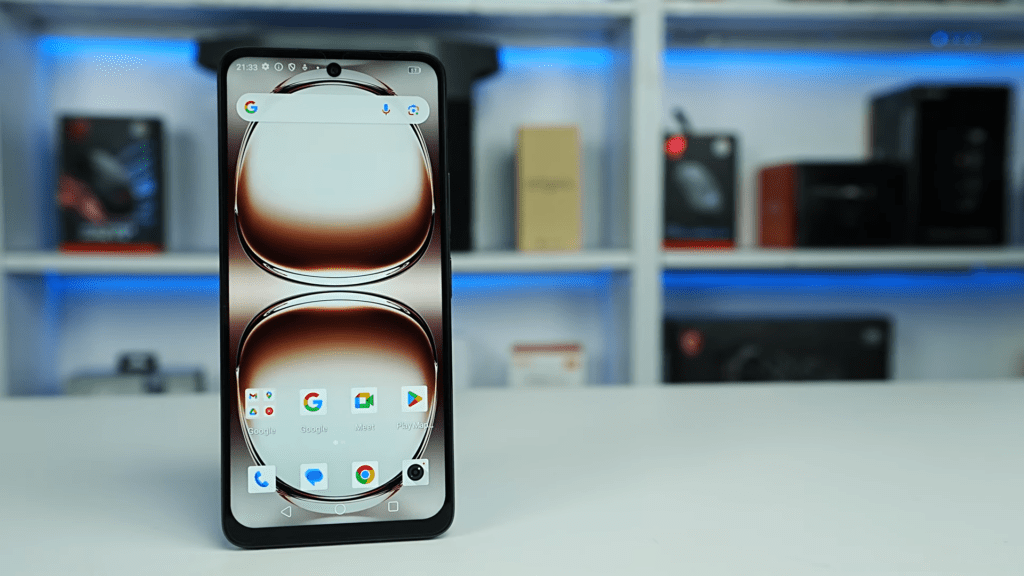Let’s cut to the chase. Not everyone wants to drop a ton of cash on a phone, especially if they’re just looking for something reliable for everyday tasks. Enter the UMIDIGI Note 100A—a phone that proves you don’t need to empty your wallet to get decent performance and a few standout features. This little guy might not be breaking any records, but it’s got enough going for it to make you think twice about spending more.
Design
First off, let’s talk about how this phone looks and feels. The UMIDIGI Note 100A is slim—just 7.7mm thick—and weighs around 190 grams. It’s light enough to hold comfortably for long periods without feeling like a brick in your hand. The back panel has this cool “porthole” camera module design with a textured finish, which gives it a premium vibe despite being made of plastic. And hey, it comes in four colors: black, white, blue, and green. So, you’ve got options to match your style.
The build quality is solid for its price range. Sure, it’s not made of glass or metal, but it doesn’t feel cheap either. Plus, it’s got IP53 protection, meaning it can handle a bit of dust and water splashes. You won’t have to panic if you spill coffee on it or get caught in a light drizzle.
Screen
Now onto one of the biggest selling points—the display. The UMIDIGI Note 100A sports a massive 6.8-inch IPS screen with HD+ resolution (1600×720 pixels). While the pixel density isn’t groundbreaking at 258 PPI, it’s sharp enough for daily use. Colors look natural, and viewing angles are decent thanks to the IPS panel. But here’s the kicker: it has a 120Hz refresh rate. Yep, you heard that right. For a budget phone, this is a game-changer. Scrolling through apps, browsing social media, or even playing casual games feels buttery smooth.
One downside? The brightness tops out at around 450 nits, which makes outdoor visibility tricky under direct sunlight. Still, crank it up to max, and you’ll manage just fine most of the time. Just don’t expect Gorilla Glass-level durability—it ships with a basic protective film, so consider grabbing a screen protector if you’re clumsy like me.
Specs & Software Experience
Under the hood, the Note 100A runs on an octa-core Unisoc Tiger T615 processor paired with 4GB of RAM. There’s also a feature called virtual RAM expansion, which borrows storage space to give you an extra 4GB of RAM when needed. In practice, this means the phone handles multitasking fairly well. I had no trouble switching between apps like YouTube, WhatsApp, and Chrome without noticeable lag.
Storage-wise, you get 256GB out of the box, expandable up to 1TB via microSD card. That’s plenty for photos, videos, music, and apps. Keep in mind, though, the hybrid SIM slot means you’ll need to choose between having dual SIM functionality or adding storage. Gamers should temper their expectations; while lighter titles run smoothly, demanding 3D games require low graphics settings for playable frame rates.
The UMIDIGI Note 100A ships with Android 14 right out of the box, which is rare for a budget device. Even better, it’s almost stock Android with minimal bloatware. This keeps things snappy and ensures updates will likely roll out faster compared to heavily skinned versions.
Cameras
Photography isn’t exactly the Note 100A’s strong suit, but it gets the job done for what it costs. On the back, you’ve got a dual-camera setup: a 13MP main sensor and a 2MP secondary lens for depth effects. Daytime shots are clear and vibrant, though nighttime pics struggle with noise and detail retention. The portrait mode works okay during the day but falters in low light.
Up front, the 8MP selfie cam captures decent selfies in good lighting conditions. It struggles indoors or in dim environments, but again, this is par for the course in budget phones. Video recording is functional rather than fantastic, with stable footage at 1080p but limited dynamic range.
Battery Life
If there’s one area where the UMIDIGI Note 100A truly shines, it’s battery life. With a beefy 5000mAh cell inside, this phone easily lasts a full day of heavy use—or two days if you’re more moderate. During testing, it delivered around 8-9 hours of active screen-on time, which is pretty impressive for a device in this category. Charging happens over USB-C, and while the bundled adapter only supports 10W charging, the phone itself can handle up to 20W fast charging if you upgrade the charger. A full charge takes about two hours, but hey, slow and steady wins the race.
Final Thoughts
The UMIDIGI Note 100A isn’t perfect, but it doesn’t pretend to be. What it does offer is a sleek design, a big and smooth display, great battery life, and clean software—all for a price tag that won’t break the bank. It’s ideal for anyone who needs a reliable phone for calls, messaging, browsing, and streaming without splurging on unnecessary bells and whistles.
For the money, it’s hard to find much fault with this device. It ticks all the boxes you’d want in a budget smartphone and then some. If you’re after value for money, the UMIDIGI Note 100A deserves a spot on your shortlist.

